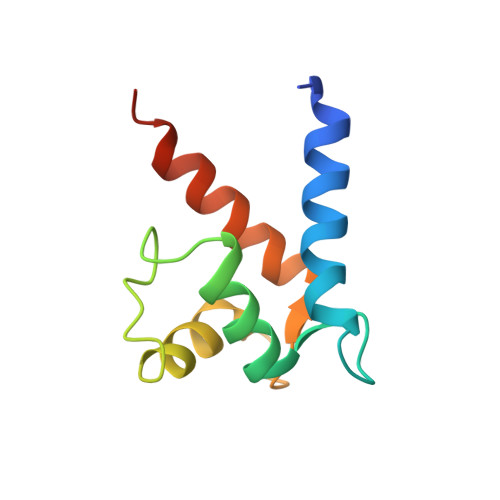Crystal Structure of Human Profilaggrin S100 Domain and Identification of Target Proteins Annexin II, Stratifin, and HSP27.
Bunick, C.G., Presland, R.B., Lawrence, O.T., Pearton, D.J., Milstone, L.M., Steitz, T.A.(2015) J Invest Dermatol 135: 1801-1809
- PubMed: 25760235
- DOI: https://doi.org/10.1038/jid.2015.102
- Primary Citation of Related Structures:
4PCW - PubMed Abstract:
The fused-type S100 protein profilaggrin and its proteolytic products including filaggrin are important in the formation of a normal epidermal barrier; however, the specific function of the S100 calcium-binding domain in profilaggrin biology is poorly understood. To explore its molecular function, we determined a 2.2 Å-resolution crystal structure of the N-terminal fused-type S100 domain of human profilaggrin with bound calcium ions. The profilaggrin S100 domain formed a stable dimer, which contained two hydrophobic pockets that provide a molecular interface for protein interactions. Biochemical and molecular approaches demonstrated that three proteins, annexin II/p36, stratifin/14-3-3 sigma, and heat shock protein 27, bind to the N-terminal domain of human profilaggrin; one protein (stratifin) co-localized with profilaggrin in the differentiating granular cell layer of human skin. Together, these findings suggest a model where the profilaggrin N-terminus uses calcium-dependent and calcium-independent protein-protein interactions to regulate its involvement in keratinocyte terminal differentiation and incorporation into the cornified cell envelope.
Organizational Affiliation:
Department of Dermatology, Yale University, New Haven, Connecticut, USA; Department of Molecular Biophysics and Biochemistry, Yale University, New Haven, Connecticut, USA; The first two authors contributed equally to this work.. Electronic address: christopher.bunick@yale.edu.
















